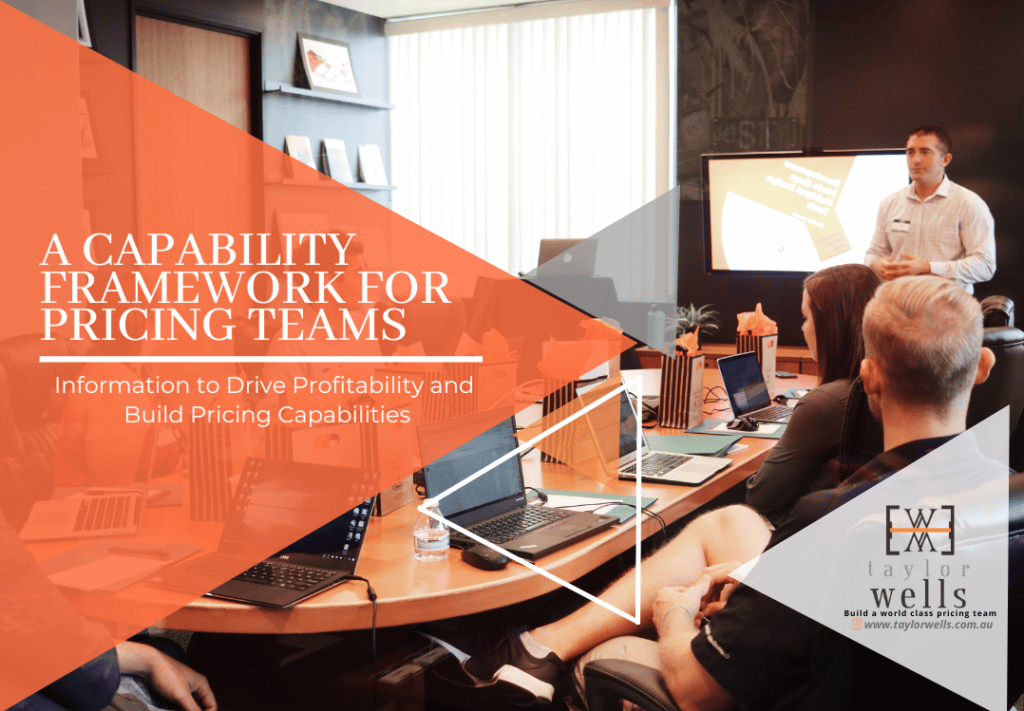
Are Your Pricing Capabilities Optimised Or A Profit Liability? 🌈
Dangerous and often latent organisational views and assumptions on latest pricing capabilities, such as price optimisation circulate at every level of your business everyday:
“Changing prices is easy.”
“Anyone can move prices around in a spreadsheet.”
“Why do we even need a price list?”
“What’s the harm in giving customers more discounts and freebies.”
>Download Now: Free PDF A Capability Framework for Pricing Teams
In effect, all of the above views on price optimisation are unwarranted and ill-informed. What’s more, their existence is a serious profit liability for your business.
Indeed, any CEO who’s asked their teams to change prices across thousands of different SKUs and hundreds of customers will testify that even changing prices was not easy – let alone setting prices for new products.
Likewise, any business or commercial manager that has been given the task of setting new prices for high-value products in new markets will say that once they started to calculate the price more broadly than just the sum of its costs pretty soon realised that building a meaningful price ladder was multifaceted and by no means easy.
- How do your customers really value your products?
- How will they perceive the price?
- Would they pay more or less than you think they’d pay?
- What will competitors do in response to this price?
- Should you be setting prices differently for different customer groups?
- How can you do tiered pricing properly without upsetting your customers?
These are just some of the questions good pricing managers consider when they set or optimise customer invoice prices to safely drive profitability.
Not aligning your pricing to your customers and the market is a profit risk. It’s time to inform views on pricing capabilities and give yourself and your teams the best chance to capture the price premiums you truly deserve for the great products and services you deliver to your customers. This can only be done by building your teams’ pricing capabilities.

〉〉〉 Contact Us for a FREE Consultation
Building your pricing capabilities
In this article, you will learn about the importance of pricing capabilities in implementing a price optimisation strategy. Tips and proven pricing processes are included.
We will argue that it takes investment in your strategy, people and operations to truly develop pricing capabilities.
We’ll explore a real life case study and 5 obstacles preventing Australian businesses from achieving a real capability.
We strongly believe that it’s a huge risk to reduce pricing down to tactics or random numbers in a spreadsheet, especially in downtime or during a crisis.
Case study: Not having any pricing capabilities is a serious profit-risk
Price setting and price getting are not based on luck, it requires discipline and expertise in price optimisation. All businesses have the opportunity to improve their pricing performance, as long as they take care of pricing in an organised way and know what they are doing.
What does it take to optimise prices? The simplest form of price optimisation includes: understanding basic financials – like variances in sales, volumes and margin from this year and last year plus a view to list price realisation by SKU and trends in average price points – price elasticity modelling, but it also requires that you understand what your customers value and are willing to pay.
As you can see, as you make your price algorithm longer, price optimisation becomes less easy and this is why many businesses are hiring pricing teams to improve their pricing capabilities. Unfortunately, many companies are reluctant to put in the effort into improving their pricing capabilities and decisions at any meaningful level. Many, for example, are still in the dark about the importance of good pricing and the impact price optimisation can have on the P&L. According to research, the average business only spends less than ten hours per year on their pricing techniques which is not enough at all. What’s more, this neglect of pricing is a serious profit risk.
Let’s take J.C. Penney for example which had the biggest pricing strategy failure in 2012.
J.C. Penney made a bold and risky price experiment with “fair and square” pricing that basically removed all deals, offers, sales, and pamphlets in the Sunday paper. However, after over a year of trying to make it work, J.C. Penney was not successful. They failed so hard that they were named the biggest pricing failure of 2012. Revenue only went back when they returned to the traditional retail promotion strategy. Let’s examine why the experiment failed, consequently, you’ll get some lessons that you can implement in your pricing optimisation strategy.
Traditional retailers, like J.C. Penney, tend to use pricing tactics rather than strategies that often work to create a pricing trigger that minimises sales cycles significantly over the mid to long term. This is where JC Penney went wrong too. For example, they totally destroyed over a century’s worth of price conditioning customers had known and loved about shops, stores, retail, and pricing in general. They assumed that they could overthrow the psychological thrills from getting the best deals without optimising prices across their product portfolio – a mistake that put them into debt because they were not covering costs and losing significant volume, revenue and margin by withdrawing all discounts and offers at once.
(Update: J.C. Penney has been struggling under a sizeable debt and bad decisions for a decade until they filed bankruptcy on May of 2020.)
Discussion
Price optimisation is not a one-off event. You can’t set and forget prices as the market changes. A 10-hour committed to pricing is a serious concern. In effect, you want a full-time pricing manager to manage price optimisation to ensure your prices are aligned to the market and making money for the business. Don’t assume this happens on its own.
Price optimisation is an important part of a revenue strategy. Many studies reveal that price optimisation techniques (raising and lowering prices to optimal levels) have a considerable and immediate effect on company profitability of c. 20% or 50% approximately.
But, for many companies, there’s still a lot of room for improvement in the area of price optimisation. Optimising your product prices to level value with margin can have a substantial effect on your company’s growth. However, it’s not as simple as crudely raising prices using guesswork or crudely removing discounts in one fail swoop. This is why good pricing requires lots of data and research into the market, competitors and customers.
However, the work invested in price optimisation is worthwhile. What’s more, you’ll see an increase in profits in less than 3 months. This is because, once you’ve got your key variables for optimisation lined up, and your price architecture is designed correctly, you can quickly optimise prices across every SKU to boost profitable revenue growth — even if you have over 50,000+ SKUs to deal with. But, whatever you do, don’t just remove discounts without having another plan in place; change prices or apply set increases across the board like J.C. Penney. This is the opposite of price optimisation and will get you into serious trouble.
So what should you be focusing on? Answer: 3 Pillars of Pricing Capabilities
Numerous businesses have now proved that a 1% improvement in price optimisation provides an average increase of 11% in profit. In addition, price optimisation techniques also help businesses to improve their marketing to product to sales processes.
So, to find the right pricing strategy for your business (and avoid the risk of profit loss), consider implementing the three pillars of pricing capability (listed below) in your business sooner rather than later. Not only do these 3 pillars will set your whole pricing and revenue management system up for success, but they’ll also ensure that any price optimisation solution runs efficiently.
1. People
Pricing process doesn’t run on automation; at least not yet. It needs people who are familiar in pricing strategy, range of products or services, customers, suppliers and competitors. Companies can train the current workers and also hire qualified people in business school or experienced executives who are experts in pricing.
Companies who don’t have these people are caught in an endless loop of catch-up with the competitors who invested in human capital.
2. Operations
Having people who are capable of creating pricing strategies isn’t enough to have pricing capability. Companies need to invest in software and hardware systems to collect, share and analyse data. One great example is the Amazon pricing system. It developed a system and human capital to work harmoniously to find the right prices.
All the information from the purchases is found on its website; they are constantly analysing the data in all the transactions. Therefore, its pricing analytical program enables the dynamic pricing program efficiently.
3. Strategy (not forgetting culture!)
Although the two above pillars are important in pricing capability, there is one more to bring all these together. Thus, this is what puts the right price at the right time. Without this, there will be a total meltdown in staff and customer relationships. Therefore, investing the time to develop this will optimise the people and operational pillars of pricing so management can improve upon its pricing capability.
Companies need to develop teams that anticipate and manage customers’ response to price changes, involving lead users, conduct market research, and study of price change predictor.
Implications
Many companies follow the pricing trends of their competitors and end up costing them more than their competitors. In such cases, you shouldn’t aspire to be a price leader but to find innovative ways to attract customers.
Creating the right uniform pricing strategy can be a complex endeavour that brings out insecurities in the best of us. However, once you overcome the obstacles, your pricing capability will outlast the competition and bring in more profits.
Tips: To get drive organisational pricing capabilities using an easy five-step process:
Step 1:
Determine your business goals. How you make money determines everything about your pricing and sales strategy.
Step 2:
Create a thorough market pricing analysis. Hence, while the first step is about your business goals, this step ensures that your pricing strategy considers the context of the market in which your product or service will compete.
If your market and product are broader against many players who offer similar products or services, chances are you will compete on price. Hence, you will need to properly plan to keep operational costs down to ensure a maximum profits margin.
Step 3:
Analyse your target audience. In effect, this step enables you to answer why, what, and how customers will value your product or service based on their specific and urgent needs. Therefore, ask yourself the most important question: “what perceived and real value does my product or service bring to the customer?”
Your pricing model and promotional campaigns must align with why your customer would buy your product. For example, if you have the best product that uniquely fulfils a customer’s urgent needs, value-based premium pricing may be the best strategy. In effect, creating low-cost promotions and giveaways will confuse your customers, undercut your value, and shrink your profit margin.
Step 4:
Profile your competitive landscape. Hence, whether you are a low-cost provider or a differentiated vendor, the pricing model and price point of your competitors is a significant pricing strategy mover.
Identify at least three direct competitors. Study the structure of their pricing. For example, do they have component pricing and allow for heavy discounts? Do they bundle with other products or solutions? Or, do they employ value-based pricing where clients pay a percentage of the total perceived ROI?
Step 5:
Create a pricing strategy and execution plan. At this point, you have enough information to formulate an action plan. Hence, use the information on product value, price perception of the customers, the competitors’ reaction to your prices and tiered pricing of your products. This will improve your pricing capability.
Once you completed the five steps, review them one more time. In addition, this will help you ensure that the strategy you chose to take gives you a chance at successfully competing in your target market segments, gaining revenue and market share.
〉〉〉 Get Your FREE Pricing Audit 〉〉〉
Conclusion
Companies that don’t have a pricing capability won’t be able to extract a larger share of wallet using the latest price optimisation techniques.
A strategic pricing capability is an important contributor to the company’s long-term existence. Strategy and culture are unique that they cannot be acquired or bought. It takes time to develop and nurture your organisationa pricing capabilities. All too often, companies use technical and legal jargon to justify their pricing or mask their guesswork. In effect, this drives away staff and customers and erodes margin, profitability and market share.
Click here to access a free guide on building an effective pricing capability today.
For a comprehensive view and marketing research on integrating a high-performing capability team in your company,
Download a complimentary whitepaper on How To Maximise Margins.
Are you a business in need of help to align your pricing strategy, people and operations to deliver an immediate impact on profit?
If so, please call (+61) 2 9000 1115.
You can also email us at team@taylorwells.com.au if you have any further questions.
Make your pricing world-class!
Related Posts
Leave a Reply Cancel reply
Categories
- marketing strategy (26)
- Organisational Design (14)
- Podcast (114)
- Pricing Capability (87)
- Pricing Career Advice (10)
- Pricing Recruitment (19)
- Pricing Strategy (290)
- Pricing Team Skills (13)
- Pricing Teams & Culture (24)
- Pricing Transformation (47)
- Revenue Model (25)
- Sales Effectiveness (27)
- Talent Management (7)
- Technical Pricing Skills (35)






